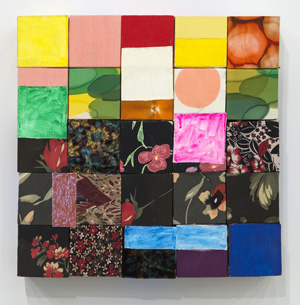
Put on a Show
Let’s put on a show! If that sounds like bad memories of summer camp, summer group shows are often like that. As commercial pressures mount, all but the priciest galleries take shorter public breaks. (The lucky few can safely wheel and deal in private.) And as pressures mount, they then need an excuse to stay open. Imagine the collector’s point of view. 
Haul out the gallery artists? Been there, done that—and besides, art fairs now serve that purpose. A theme show? Entertaining at best, like a riff on bicycles recently at Marlborough on the Lower East Side (through August 3). Survey a medium or a style? That worked a few summers ago, but it took perfect timing—a hot downtown scene, fantastic coordination among several dealers, and the return of abstraction. Creative shows this summer take up photography as object and a half-forgotten French movement, “Support/Structures,” but I examine those in more detail elsewhere.
That can leave little more than the sensibility of the curator, like a tribute at 33 Orchard (through July 26) to Hunter, founder of the late lamented Feature gallery. Its packed walls honor his accessibility to unsung artists. Yet they also mean another evening matching too many names to too much art. Still, a sensibility does matter—if that means experience, thought, and feeling. Consider, then, how this year’s sensibilities translate into themes, styles, and trends. Any one of them can put on quite a show.
Could two different galleries have stumbled on disaster? “About a Mountain” at Asya Geisberg (through August 15) may have you thinking of Paul Cézanne and Mont Sainte Victoire. Yet it meant Yucca Mountain, and somehow Gerhard Frommer’s sharp colors, Rachel Niffenegger’s stained shroud, and a copy of The Scream commissioned from a Chinese Web site all attest to the anxiety of the art world.
Meanwhile James Cohan (through August 8) has had the quiet attention of Mark Dion in his studio, the apocalyptic landscapes of Alexis Rockman, mappings from Pierre Huyghe, a limp reindeer from Carsten Höller, wildlife reduced to their weight in abstract marble from David Brooks, a kitchen turned inside out from Alison Elizabeth Taylor, a forest of future books by Katie Paterson, the decorative excess of Fred Tomaselli, an apple after Alfred Stieglitz from Erin Shirreff, and the romantic Modernism of Charles Burchfield. All attest to a disruption in the cycles of nature, “The Fifth Season.” And yet they, too, are meditating as much on art’s cooling as on global warming.
While Postmasters sticks up for sculpture and Lesley Heller connects art and poetry (the subjects of separate reviews), others return to painting. Zach Feuer (through July 26) puts in a plea for imagery, with its usual surfeit of irony, while Sargent’s Daughters (through July 26) puts representation in the shape and hands of women. McKenzie (through August 2) argues for “Color as Structure,” from Cordy Ryman in wood to the networks of Kate Shepherd, Jason Karolak, or Rob de Oude. Elizabeth Harris, in contrast, is loosening up (through July 25), as Gary Petersen, Joanne Matera, and others discover unexpected space in their color weave.
While The Hole (through August 23) indulges in spray paint, Pablo’s Birthday (through August 3) opts for more than a pat recap of Brooklyn abstract art, with names I shall definitely be tracking. From smeared paint to collaged fabrics, its artists treat flat surface as three-dimensional substance.
It takes two galleries to assert a sensibility for Detroit alone (at Marlborough in Chelsea and Marianne Boesky, again with a separate review). Is there still a hipper sensibility on the Lower East Side? And does it matter that the galleries there are growing larger by the month?
At Lisa Cooley (through August 1), Cynthia Daignault and Mark Loiacon as curators delight in excess—from Judith Linhares in expressionism to Nancy Shaver with colorful blocks or from Sheila Hicks in fabric to José Lerma with painted flowers. Kamau Amu Patton’s LED strip, Victoria Fu’s abstract prints, Margaret Lee’s leopard-skin Brancusi, and Rory Mulligan’s dad staring at the moon add the poetry of restraint. Try to look at them all through David Kennedy-Cutler’s crumpled, transparent draperies without walking into any of them.
The neighborhood’s hip and industrial sensibilities meet at Laurel Gitlen (through August 8). Nancy Lupo’s toilet paper and plastic containers surround Sean Paul’s black mesh, printed with abstraction on one side and advertising on the other. So much for truth to independent media.
Rachel Uffner says it all in calling a huge show “Crystal Palace” (through August 16), filling two floors with the archives of an Upper East Side gallery, Richard L. Feigen. Can one trace the 1960s unease of James Rosenquist and Robert Indiana at once back to Joseph Cornell and Balthus, “outside” to Ray Johnson and Peter Saul, and sideways to Sara VanDerBeek and Stan VanDerBeek? For better or worse, downtown is looking up.
| Read more, now in a feature-length article on this site. |
SOURCE: Haberarts – Read entire story here.